Like it or not, new car manufacturing is dead in Australia. The big-wigs have lost the plot, producing cars that aren’t viable for the market. Ford realised this a long time ago, essentially phoning in the last few Falcon’s while they focused their attention on dual cab utes, SUVs and hot hatches, which would hopefully be a saviour for Ford Australia. Holden is late to the game, but with Commodore in its death throws it seems they’re finally starting to realise if they want a future in Australia it’ll be with four doors and a transfer case, not with high-po V8s and flamboyant body styling. What does all this mean for camper trailers? Absolutely nothing. And everything.
Despite the Falcon and Commodore dying, the rivalry for new-car dollars won’t stop between Ford and Holden. They’re just going to be throwing their weight into a different market, with the end result being better 4WD for us as we’re their main market, and not a distraction.
What you’re looking at now is Holden’s first serious attempt to take on the dual-cab market, and this is its top-dog, the American inspired Z71 Colorado. It’s packing 500Nm under the bonnet, a 3500kg towing capacity, and plenty of tech to making towing easier. Despite one of the boasted features of the new model being a “black tailgate handle” we figured it was well worth a look at what very well could be the saviour for Holden.
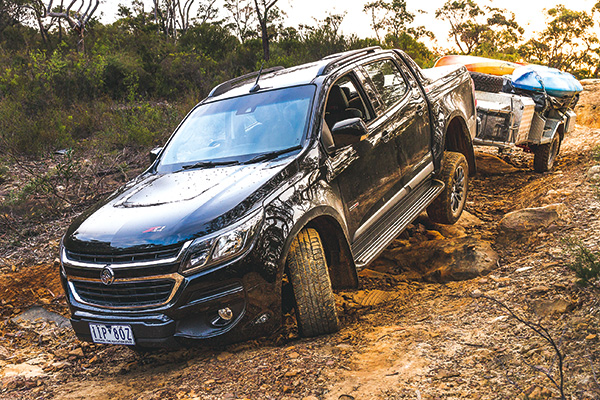


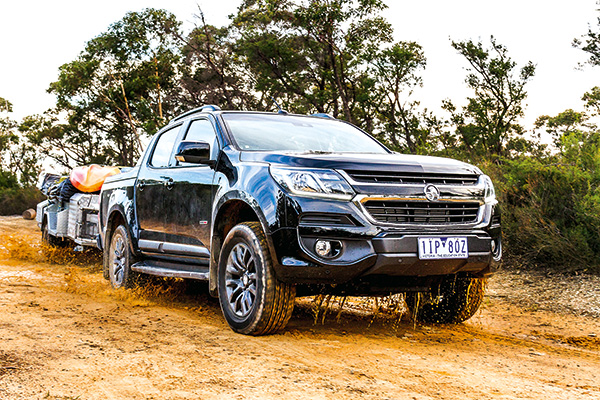

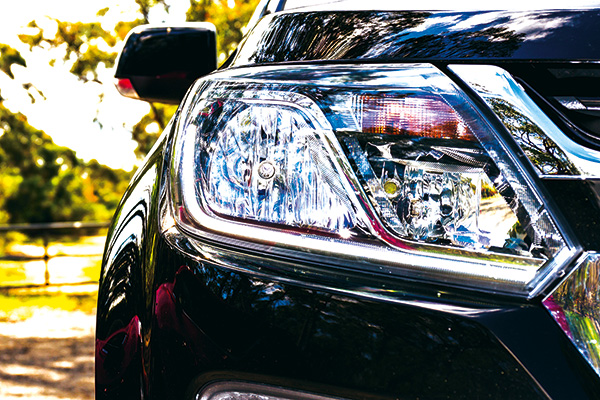
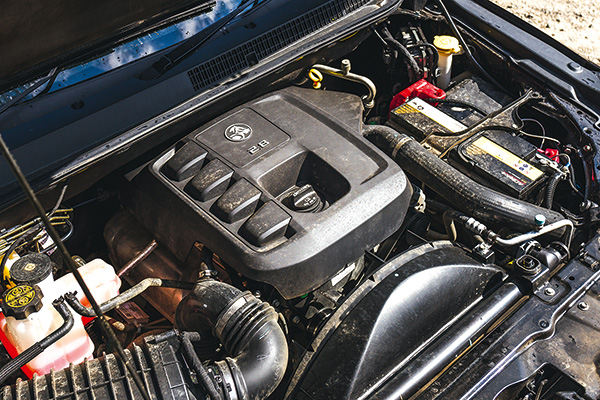

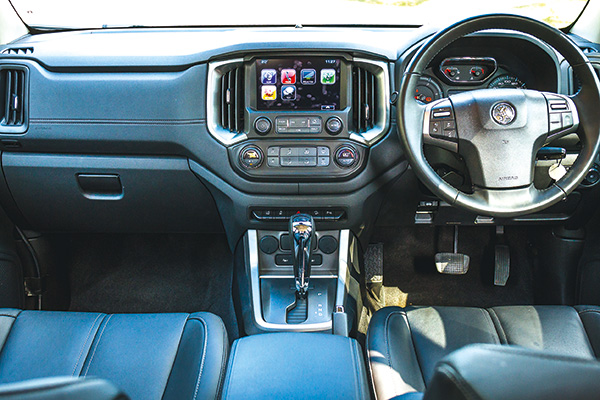

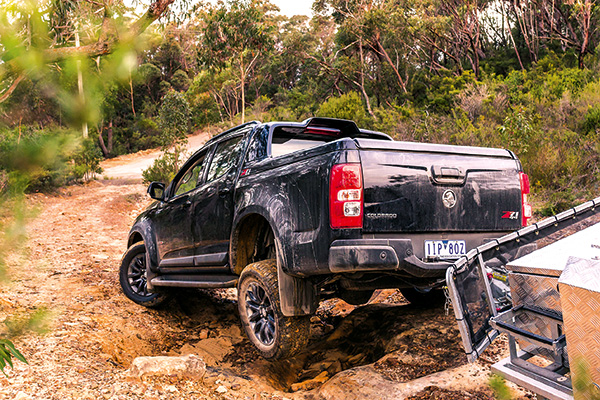
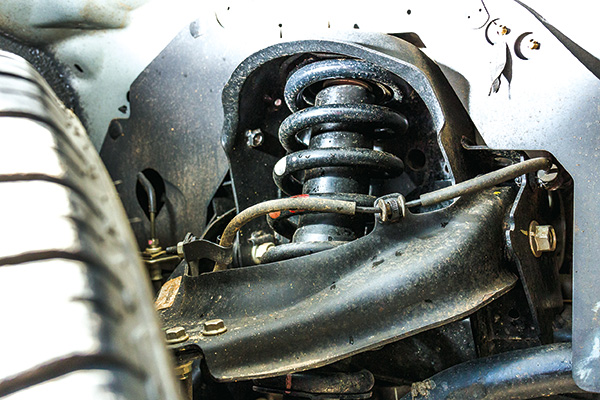
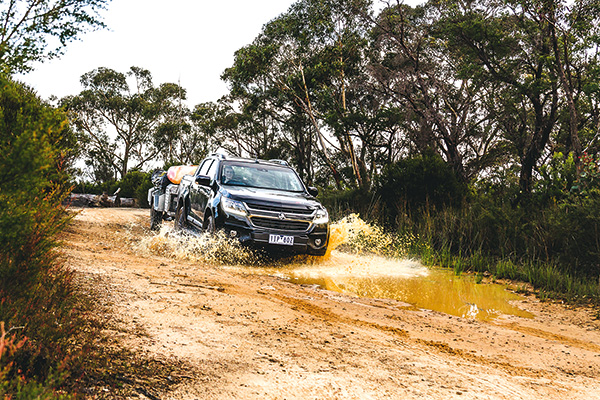
FIRST IMPRESSIONS
At first glance the Z-71 comes across as something pretty damn serious. There’s menacing blacked out wheels, blacked out highlights on the bonnet and down the flanks, and a stance that clearly separates it from the lower-tier models… although the 1980s speedboat sail over the tray and lower-clearance front bumper might not appeal to everyone. Swinging open the front door and sliding down into the deep leather bucket seats and things start turning positive again. There’s been a huge overhaul since the previous model and it’s obvious Holden has put their head down and bum up to come up with a serious competitor in the dual-cab ute market. It feels leaps and bounds ahead of the previous generation despite boasting the same power figures and with largely unchanged styling.
From the captain’s chair everything falls to hand easily, controls are where you’d expect them, gauges say what you want them to say, and most things are easy to work out without consulting the owner’s manual. While it’s subjective, we found the driving position to be a perfect mix of low enough for comfortable commuting, but high enough you’re not constantly climbing out of your seat just to see when offroad; although there is plenty of adjustments to get it to your liking. One thing that was quite surprising, is despite the Colorado being in-line with all the other models in terms of overall size, it did feel cramped inside. Passenger and driver seemed close together, and rear seat occupants can easily ruin your trip with a few well-placed knees.
Twisting the key springs the Duramax into life (no fancy push button here folks), and despite it looking the same on paper as it always has it’s noticeably smoother than previous models and feels a lot sprightlier off the line. Holden has done a whole bunch of technical changes throughout like thicker glass, lower gear ratios, and internal engine and transmission modifications with the end result being a far less agricultural offering and something you’d be happy living with between camping trips.
IN THE THICK OF IT
Like most modern 4WDs, you don’t muscle the Colorado into low-range with a heave and a grunt, instead it’s a delicate flick of the wrist with a plastic dial. Hardly inspiring, but the times are a changing. High-two to high-four can be done on the fly, but you will need to come to a stop and select neutral before going into or out of low-range; an understandable requirement coming from Holden, but a frustrating one when you’re used to blipping the throttle and shifting out of low-range on the fly.
Heading offroad and the Colorado is more capable than its spec sheet would suggest. There are no diff locks, no slinky suspension, and no clever 4WD systems either. But despite all that it’s reasonably sure-footed in difficult terrain and was able to easily negotiate its way through our test track, although admittedly we did refrain from driving up one section due to concerns of ripping the bulbous front bar to pieces. The bar isn’t the only concern either, with the low-profile shod 18in rims restricting the footprint even at low psi and getting perilously close to a few stray rocks we didn’t want to explain to Holden. Luckily both are some of the first things people upgrade when building a tourer so shouldn’t be a deal breaker for most people.
Despite peak torque being higher in the rev range than most of its competitors, the updated six-speed automatic helps hide any of its strange characteristics, and with a lower first gear than previous models provides plenty of low-speed control. It proved more than enough to muscle the campers 910kg tare weight around. Even when wheels were bound up, the hill-start-assist gave us plenty of time to apply power smoothly without worrying about being pulled back down the track camper first. Like many recent technological advances, it’s designed for the inner-city bearded-lady but works exceptionally well offroad. The wading depth is another astonishingly average feature of the Colorado, clocking in at 600mm through still water compared to the Ranger’s 800mm, HiLux’s 700mm, Amarok’s 500mm and the NP300s 450mm, although if you’re doing any touring a snorkel will be one of the first upgrades anyway.
We’ve spoken about genuine accessories before and how they can make or break a vehicle, so despite this vehicle coming factory fresh it’s worth mentioning Holden has a seriously comprehensive list of genuine kit. Not your usual half a snorkel and goofy looking canopy either, right off the showroom floor Holden offers gear like full steel underbody protection, a beefcake steel rear bar with steps for easy access to the tray, half a dozen bull bars with at least one of them not completely ugly, and even HID driving lights, LED lightbars and flares for larger offset wheels and tyres. It’s hardly the full ARB catalogue, but considering it’ll all be on there from day one and come under the one finance payment it’s something to seriously consider and will drastically improve the Colorado’s offroad performance.
GADGETS AND GIZMOS
One of the biggest changes in the updated Colorado has been the addition of a metric-tonne of technological goodies. Some are fantastic, while others left us wanting more. One worth mentioning on the Colorado is the gauge cluster. It’s a simple arrangement with two analogue gauges and a digital readout in between, not unlike many other offerings, but what makes the Colorado unit stand out is how in-depth the information goes. While most readouts give you wishy washy info the Colorado is able to tell you specifics. Like exactly how hot the transmission gets when you hitch the camper and drag it through soft sand, how hot the engine gets on long steep climbs, and even PSI accurate readouts for tyre pressures. The downside is it still uses the stalk mount controls to navigate your way through the menus leaving you feeling like you’re playing a game of tennis on the Nintendo Wii just to check your odometer. While many models now offer lane keep assist and adaptive cruise control, the Colorado just beeps at you as you run off the road or rear end a truck as you’re fiddling with the control stalk.
There’s all the usual gear you’d expect too, like hill start control, hill descent control, a heap of airbags, stability control and traction control but the more appealing features for towing are trailer sway control and roll over mitigation. Two entwined systems that can brake individual wheels to get an unruly tow-rig back into line when things get pear-shaped. They're very welcome additions in the Colorado and far more important than leather wrapped mirrors and radar controlled cup holders.
While you’re on the road the huge 8in stereo is easy to use with large clear to read buttons and a responsive touch screen so you’re not mashing at it just to change the station. The usual suspects are there like Apple Car Play and Android Auto, both of which allow you to stay connected on the road without fumbling with your phone at traffic lights like a naughty teenager. Likewise the climate control is easy to use with two large dials and an array of buttons getting the job done, there’s no dual zone control but the passengers in the rear do get outlets which could be a deal maker for young families.
BUT DOES IT TOW?
While Z28 normally means mullets and Aerosmith, Z71 in the General Motors stable indicates a towing package. Depending on the model of big ol’ American pick-up the sticker is slapped on it can mean anything from offroad suspension, beefier rear axle, diff locks, or more power. In the Aussie delivered Z71 it sadly means none of that. Now that’s not to say it should be written off as a tow-tug, but it did leave us a little disappointed as we made our way through the features list.
That’s the bad. Now for the good. With just 2.8L and four-cylinders thumping away under the bonnet the Colorado punches well above its weight, pushing out 500Nm of torque. For comparison’s sake the similar sized HiLux offers 450Nm, while the 3.0L V6 Amarok pips top spot with 550Nm. Match that with a greatly improved six-speed auto and the Colorado has no issues telling a camper who’s boss on and off the blacktop. Despite the transmission occasionally fumbling to find the right gear when maintaining speed it always got it right when we squeezed the loud pedal for some strategic overtaking and would happily downshift a gear or two to provide engine braking when it sensed we were travelling downhill, without requiring us to tap the brakes like most models do. Like most modern dual cabs the 3500kg tow rating is VERY optimistic, but there’s more than enough grunt to deal with your average camper trailer and a tray full of gear.
The Colorado’s unladen ride is almost faultless and could easily do family duties without shaking you to bits, yet despite that it’s also able to easily cope with having a trailer hitched to the rear without any noticeable sag or bouncing around like a chemically enhanced clown as the trailer bounds along through uneven terrain. That said, the brakes did leave us wishing for more and relying on the trailer to pull itself up more than we would have liked, so quality trailer brakes are a must. All up we racked up near on 2000km in the week and a bit we had the Z71. From freeways and winding back country roads to corrugated fire trails and sand stone rock ledges it never felt like we were asking more of it than it could deliver.
THE VERDICT
Avert your sensitive eyes RG Colorado owners. The previous offering from Holden was seriously behind the 8-ball in just about every way. It was brash, rough, poorly laid-out, and far more in line with utes of 10 years ago than the do-it-all machines they’ve become recently. That said, the updated Colorado is leaps and bounds better than you’d ever think the RG could be, especially with what are essentially minor changes. It’s nicer to drive, tows better, has less cabin noise, and heaps more usable tech. It’s an all-round more enjoyable place to be and something I’d gladly drive to Fraser Island for a family getaway with camper in tow.
But it’s still not enough.
It’s perfectly acceptable and owners can hold their heads high; but as the death of Commodore looms nearer and the best offering Holden can come up with for one of the biggest market segments is ‘acceptable’ it doesn’t say much for their long term viability on Australian shores. Yes, the new Colorado is a massive improvement over the older model and would make a perfectly competent tow-rig cum 4WD, it’s just unfortunate for Holden that while they were playing catch-up everyone else was making giant leaps forward. They’ve gone from the back of the pack, to the top of the middle, but there’s no trophies for the tallest midget.
HITS AND MISSES
Pros
- Most powerful engine in class
- Great range of accessories
- Easy to use dash
- Nimble on the black top
Cons
- Lack of power options
- Poor quality rear view camera
- No rear locker
SPECS
- Tare: 2143kg
- GVM: 3150kg
- GCM: 6000kg
- Towing Capacity: 3500kg
- Engine: 2.8L 4-cylinder turbodiesel
- Torque: 500 @ 2000rpm
- 4x4 System: Part-time dual range
- Fuel Consumption: 10.7L/100Km as tested
- Fuel Capacity: 76L
- Suspension: Front: independent double wishbone coil Rear: Live axle leaf spring
- Brakes: Front: disc; Rear: drum
- Seats: 5 (2/3 configuration)
- Wheel/tyre: 18in alloy 265/60 R18
- Style: Dual-cab ute
PRICE AS SHOWN
$59,288 Driveway, inc. towing package




